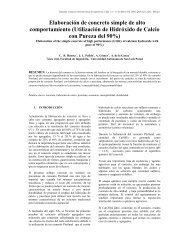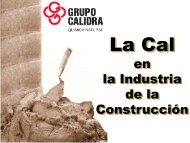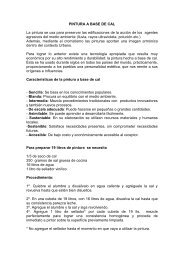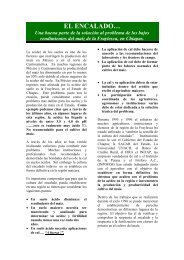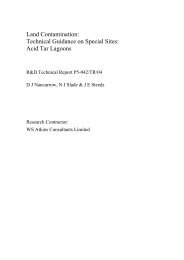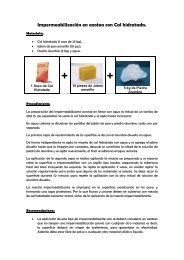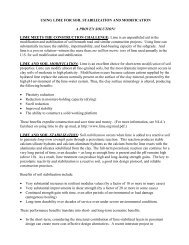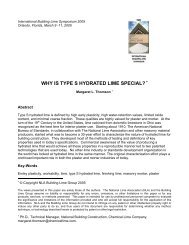Steel Plant Training Course - Anfacal
Steel Plant Training Course - Anfacal
Steel Plant Training Course - Anfacal
You also want an ePaper? Increase the reach of your titles
YUMPU automatically turns print PDFs into web optimized ePapers that Google loves.
© Carmeuse Technical <strong>Training</strong><br />
<strong>Steel</strong> <strong>Plant</strong> <strong>Training</strong> <strong>Course</strong><br />
Section II: What is Slag? Basic <strong>Steel</strong>making for<br />
Electric Arc Furnaces<br />
Page 1 of 25<br />
Introduction:<br />
A variety of lime products and blended lime products are used in the production of steel.<br />
In the electric arc furnace practice it is common to see high calcium pebble lime,<br />
dolomitic pebble lime and iron coated dolomitic pebble lime being charged over the<br />
roof in a bucket or through some type of feed system. New technologies are being<br />
developed to provide “co-jet” type injection of lime directly into the slag/metal interface<br />
for optimization of foamy slag characteristics.<br />
Pebble lime Iron coated pebble lime<br />
Lime being charged into a scrap bucket before<br />
loading scrap into the furnace.
© Carmeuse Technical <strong>Training</strong><br />
<strong>Steel</strong> <strong>Plant</strong> <strong>Training</strong> <strong>Course</strong><br />
Section II: What is Slag? Basic <strong>Steel</strong>making for<br />
Electric Arc Furnaces<br />
Page 2 of 25<br />
Lime injection through sidewalls of Electric Arc Furnace<br />
Lime is critical to steelmaking. The science of how lime products interact with the<br />
various components formed during melting and during ladle refining has become the<br />
basis for understanding the old phrase “ Make the slag and the steel will make itself.”<br />
<strong>Steel</strong> production involves an oxidation process usually in the furnace and a reduction<br />
process usually in the ladle that depends on lime to refine impurities from the liquid<br />
metal through formation of a liquid slag that reacts with the liquid metal.<br />
Remember, oxidation is simply the addition of oxygen into the furnace causing metals<br />
and non-metallics to form oxides that are lighter than the liquid steel that float to the<br />
surface of the bath. Some metallic oxides are acid products which can react with the<br />
basic refractories of the furnace or ladle unless we make a basic slag using lime and<br />
dolomitic lime that will perform this function instead. The oxygen can also react with<br />
carbon to create a gas that provides bubbles for foaming the liquid slag and for chemical<br />
energy used in melting. Examples of different methods of getting oxygen into the metal<br />
and slag are shown below:
© Carmeuse Technical <strong>Training</strong><br />
<strong>Steel</strong> <strong>Plant</strong> <strong>Training</strong> <strong>Course</strong><br />
Section II: What is Slag? Basic <strong>Steel</strong>making for<br />
Electric Arc Furnaces<br />
Page 3 of 25<br />
Badische Stahlwerks – Kehl, Germany<br />
Oxygen blowing through slag door with pipe style manipulator – Oxidation Process<br />
Gallatin <strong>Steel</strong> – Ghent, Kentuckky<br />
Oxygen blowing through slag door using supersonic lance – Oxidation Process
© Carmeuse Technical <strong>Training</strong><br />
<strong>Steel</strong> <strong>Plant</strong> <strong>Training</strong> <strong>Course</strong><br />
Section II: What is Slag? Basic <strong>Steel</strong>making for<br />
Electric Arc Furnaces<br />
Page 4 of 25<br />
When you are blowing oxygen into the scrap metal and other metallics that have been<br />
charged into the furnace, the oxygen reacts with a portion of the metals to form a new<br />
compound with oxygen called oxides. These new compounds usually are acid<br />
compounds that react with the basic bricks in the furnace or ladles.<br />
An example of the oxidation equations can be shown for oxidation:<br />
Aluminum 2(Al) + Oxygen 3(O) reacts to give Aluminum oxide (Al2O3)<br />
(acid oxide)<br />
Silicon (Si) + Oxygen 2(O) reacts to give Silica (SiO2)<br />
(acid oxide)<br />
Iron (Fe) + Oxygen (O) reacts to give Iron oxide (FeO)<br />
Carbon (C) + Oxygen (O) reacts to give CO + (O) reacts CO2<br />
(bubbles) (energy)<br />
It can be seen that there are differences in some of the properties of metals and then<br />
when they combine with oxygen to form new compounds called “oxides”. Metals and<br />
their oxides have tremendous differences as can be seen in the Table I below:<br />
Table I. Metals versus their Oxides<br />
Metal Symbol Oxide Oxide Oxide Metal Melting Oxide Melting Found in or as<br />
Name Color Temperature Temperature<br />
Iron Fe FeO Wustite Black<br />
Fe2O3 Hematite Red 2799 o F 2840 o F rust, iron ore<br />
Fe3O4 Magnetite Black 2800 o F<br />
Aluminum Al Al2O3 Alumina White 1220 o F 3,630 o F bauxite, bricks<br />
Silicon Si SiO2 Silica White 2570 o F 3137 o sand, ash in coal,<br />
F dirt<br />
Magnesium Mg MgO Magnesia White 1202 o F 5072 o gunning<br />
F material,bricks<br />
Calcium Ca CaO Lime White 1580 o F 4,658 o F lime,cement<br />
Table I. Shows the differences in melting points and colors of the oxides seen in slags.
© Carmeuse Technical <strong>Training</strong><br />
<strong>Steel</strong> <strong>Plant</strong> <strong>Training</strong> <strong>Course</strong><br />
Section II: What is Slag? Basic <strong>Steel</strong>making for<br />
Electric Arc Furnaces<br />
Page 5 of 25<br />
What is slag? Slag can look differently depending when you are looking at it and the<br />
chemistry of the slag is what influences how it looks during molten conditions. In the<br />
furnace during melting, the slag can be creamy and fluffy, it can be very fluid and watery<br />
or it can be very thick. There are reasons why the slag looks this way and what we want<br />
to understand is what causes this so we can achieve the creamy slag that will foam to<br />
protect the furnace.<br />
If you take a slag sample from the furnace and let it cool it will look very black, that is<br />
because of the “dark oxides” like iron oxide and manganese oxide that make it appear<br />
black. These were produced during the “oxidation phase” of melting.<br />
Slag comes from 4 primary sources:<br />
• Oxidation of metallic elements in the base metal<br />
Aluminum, silicon, chromium, manganese, titanium, etc.<br />
• Non-metallics<br />
Sulfur and phosphorus<br />
• Flux Additions<br />
Dolomitic lime, high calcium lime, spar, calcium aluminates<br />
• Dissolved Refractories<br />
CaO-MgO, Al2O3<br />
It is important to know which oxides are acid and which are basic in order to know what<br />
kind of refractory bricks react with these oxides. An acid slag will erode furnace linings<br />
because the bricks are basic. An acid slag contains high amounts of SiO2, Al2O3 which<br />
can make the slag thinner.<br />
A basic slag contains oxides like MgO and CaO, which makes the slag thicker. FeO is<br />
the most important part of the slag in that it will cause lime to dissolve at lower<br />
temperatures by what we call “fluxing”. If you look at the melting temperature of CaO at<br />
4,658 o F and MgO at 5,072 o F it can be seen why it would be difficult without FeO<br />
lowering the melting point to get lime or magnesia into solution where steel temperatures<br />
are below 3,000 o F. (Table I)<br />
What useful properties does slag have in electric furnace steelmaking?<br />
• It insulates the bath, reduces temperature losses<br />
• It helps in de-phosphorization and absorbs some sulfur.<br />
• It helps control the types of inclusions and traps them in the ladle.<br />
• It controls the steel oxygen levels and chemistry of the steel.<br />
• Can protect steel from oxygen and nitrogen pickup.<br />
• It protects the furnace from arc flare and refractory erosion.
© Carmeuse Technical <strong>Training</strong><br />
<strong>Steel</strong> <strong>Plant</strong> <strong>Training</strong> <strong>Course</strong><br />
Section II: What is Slag? Basic <strong>Steel</strong>making for<br />
Electric Arc Furnaces<br />
Page 6 of 25<br />
Furnace Slags:<br />
Some oxides introduced during the melting of scrap gives us no energy. They require<br />
more fluxes, which reduces iron yield. A consideration has to be made for SiO2 contents<br />
in injection carbon, dirty scrap or silica in other materials charged in the furnace.<br />
On the other hand, metals that do oxidize and hurt yield also help provide chemical<br />
energy. There has to be a balance considering the cost advantages between these<br />
concepts of energy and material requirements. Cheap scrap may not make steelmaking<br />
cheap!<br />
The main functions of furnace slag is removal of phosphorous, coating of the furnace to<br />
protect refractories and shell, shield the arc and increase electrical efficiency.<br />
There are four principles in controlling slags in steelmaking:<br />
Phosphorous removal:<br />
• Minimum slag formation – EAF<br />
- Minimum covering of the metal bath is required<br />
- Minimum B4 basicity – basic oxides/acidic oxide ratios<br />
• MgO saturated slags – EAF & BOP<br />
- Zero refractory gunning and increase in productivity<br />
- B4 basicity of 1.8 to 2.3 (CaO + MgO/SiO2 + Al2O3)<br />
• Foamy Slag Control – EAF<br />
- Foam at right time and long enough – viscosity<br />
- Fluffy to creamy slag ( saturated with CaO + MgO)<br />
- Control of FeO, C injection and control of oxygen blow<br />
• Balance of steel and slag in the steelmaking process – “equilibrium”<br />
There are two points to consider in using oxygen for making steel, it is important for<br />
phosphorous removal and carbon removal (decarburization).<br />
The balance of oxygen activity in the steel and slag can be related in the oxidation phase<br />
as well as materials being used for dephosphorization. The equation of removing<br />
phosphorous from the steel is in simple terms is like an old fashion balance. In looking at<br />
the equation for this process:<br />
2990 F<br />
2P + CaO + 5FeO P2O5 . CaO + 5Fe<br />
(oxygen activity)
© Carmeuse Technical <strong>Training</strong><br />
<strong>Steel</strong> <strong>Plant</strong> <strong>Training</strong> <strong>Course</strong><br />
Section II: What is Slag? Basic <strong>Steel</strong>making for<br />
Electric Arc Furnaces<br />
Page 7 of 25<br />
All this shows is that to remove phosphorous from the steel you have to add the things<br />
that react on the left side which is lime (CaO) and oxygen (FeO) to produce the product<br />
of P2O5 . CaO on the right side of the equation to trap in the slag. However, if you let the<br />
temperature go over 2990 o F before allowing the slag to come off you will reverse the<br />
reaction and you will get re-phosphorization! If you want to remove more phosphorous,<br />
add more lime, blow the heat down more (oxygen activity) or keep it cooler.<br />
Many reactions in steelmaking can be considered as a balance as we mentioned above.<br />
In order to control the oxygen levels in the furnace or the ladle you have to consider this<br />
balance concept.<br />
The following example of a simple balance shows that there is a relationship between the<br />
slag and the liquid metal either in the electric arc furnace or in the ladle. Before the<br />
oxygen reactions can take place in the liquid steel, the slag has to have the oxygen<br />
increase through formation of FeO, which provides for oxygen activity in the slag and<br />
steel. If the oxygen activity is high in the slag, then the oxygen activity in the steel will<br />
increase. In the case of steel in the ladle, if the oxygen activity is low in the slag, then the<br />
oxygen activity in the steel will decrease. This balance is called equilibrium.<br />
Fig. 1 Diagram showing balance concept between slag and metal
<strong>Steel</strong> <strong>Plant</strong> <strong>Training</strong> <strong>Course</strong><br />
Section II: What is Slag? Basic <strong>Steel</strong>making for<br />
Electric Arc Furnaces<br />
Page 8 of 25<br />
Coating of the furnace for refractory and shell protection:<br />
Slag is important to protect the furnace. It has to be the right kind of slag in order to do<br />
this. The chemistry of the furnace refractories is “basic” which means that acid oxides as<br />
well as FeO will attack and erode them by chemical action. The slag must be balanced<br />
toward the basic side to prevent slag erosion and for promoting foaming action. This is<br />
why we add CaO (high calcium lime) and MgO (dolomitic lime)to the slag.<br />
Coating the furnace shell can reduce the heat loss during the cooling of the shell and<br />
save energy costs. Let’s take a look at the slag chemistry and what it means for slag<br />
foaming and refractory protection.<br />
Slag Basicity:<br />
The term slag basicity is a means in which steelmakers refer to how acid or how basic a<br />
slag is in relationship to the basic refractory utilized in furnace and ladle vessels. If the<br />
slag is more acid it will erode the bricks, if it is more basic it will protect the bricks.<br />
The basicity of the slag is normally fixed by the amount of lime and dolomitic lime<br />
added, the silicon and aluminum levels of the metals charged as well as alloys. As you<br />
go lower in the ratio towards 1:1, we tend to think of that as being acid and the higher<br />
the ratio towards 2:1 we tend to think of that as being more basic.<br />
The following is an example of different slag ratios that are commonly used in<br />
steelmaking:<br />
• B3 ratio = CaO% / SiO2% + Al2O3% + TiO2%- EAF.<br />
• B4 ratio = CaO% + MgO / SiO2% + Al2O3% + TiO2 % – Normally -<br />
EAF<br />
• B5 ratio = CaO% + MgO% / SiO2 % + Al2O3% + CaF2% +<br />
(FeO%+MnO%)<br />
If the FeO + MnO components are less than 5 % they can be used in<br />
this equation. Although typically they are not introduced at all.<br />
Ladles.<br />
Therefore if we have lime (CaO) at 30% in the slag and the SiO2 is 18% with Al2O3 at<br />
8%, we would have a B3 ratio of 1.15, which is more acid in the way it acts on<br />
refractories. If we have lime at 45% in the slag and the SiO2 is 15% with Al2O3 at 6%<br />
we would have a B3 ratio of 2.14, which is more basic in the way it acts on refractories.<br />
What are the relationships of MgO and CaO and how do they make the slag foam and<br />
protect the furnace at the same time? Let’s review the main parts to this process<br />
involving MgO, FeO, oxygen content of the steel, temperature and lime additions.<br />
© Carmeuse Technical <strong>Training</strong>
© Carmeuse Technical <strong>Training</strong><br />
<strong>Steel</strong> <strong>Plant</strong> <strong>Training</strong> <strong>Course</strong><br />
Section II: What is Slag? Basic <strong>Steel</strong>making for<br />
Electric Arc Furnaces<br />
Page 9 of 25<br />
Why is MgO important to basicity? The slag contains dissolved calcium compounds<br />
and acidic compounds that cause MgO to dissolve from refractory brick into the slag.<br />
MgO will dissolve into the slag based on relationships of FeO content, basicity and<br />
temperature. The lower the slag basicity, the higher the MgO requirement for slag. An<br />
increase in FeO and temperature also increases the MgO requirement of the slag. The<br />
effects on MgO can be seen in the diagram below:<br />
Fig. 2 Graphical representation of the main effect (in wt% MgO) of factors<br />
From the Figure 2, basicity is the most significant factor on magnesia saturation.<br />
Increasing FeO and temperature also have an effect in magnesia dissolution. The<br />
percent of MgO versus the basicity of a slag for dual saturation with CaO is shown in<br />
Figure 3 below:<br />
% MgO<br />
North America<br />
% MgO vs. Basicity for Dual Saturation<br />
17<br />
16<br />
Dual Saturation:<br />
15<br />
14<br />
13<br />
12<br />
11<br />
10<br />
9<br />
8<br />
7<br />
6<br />
5<br />
Di-Calcium Silicate Ca2SiO4 [C2S]<br />
Magnesio-Wustite (Fe,Mg)Oss [MW]<br />
1 1.5 2 2.5 3 3.5<br />
BASICITY<br />
LIME 47<br />
Fig. 3 Relationship of basicity and MgO dissolution for dual saturation in a slag.<br />
(Eugene Pretorius – Fundamentals of EAF and Ladle Slags and Ladle Refining Principles -1998)
© Carmeuse Technical <strong>Training</strong><br />
<strong>Steel</strong> <strong>Plant</strong> <strong>Training</strong> <strong>Course</strong><br />
Section II: What is Slag? Basic <strong>Steel</strong>making for<br />
Electric Arc Furnaces<br />
Page 10 of 25<br />
An example of this relationship for the MgO % that can go into a slag to achieve dual<br />
saturation of dicalcium silicate Ca2SiO4 - (C2S) and Magnesio-Wustite (FeO . MgO)-<br />
(MW) is given that for a basicity of 1.5 the %MgO required by the slag would be 12.5%<br />
and for a basicity of 2.0 the % MgO required by the slag would be about 9 %. Therefore<br />
refractory wear would not be seen in any case if the MgO is added by additions of<br />
dolomitic lime early in the steelmaking process to satisfy these requirements.<br />
Slag Foaming:<br />
Several factors must be met in order to produce a slag that will foam:<br />
• Slag must contain FeO – must be enough to react with carbon to<br />
make CO bubbles<br />
• Correct viscosity or consistency to hold the bubbles as long as<br />
possible.<br />
• Sufficient MgO to minimize refractory wear and promote foaming<br />
In trying to make the right slag for foaming it is sometimes good to think about<br />
comparisons of viscosity that allows the bubbles to stay longer in the liquid. If you<br />
blow air into chocolate milk, you get it to foam up and hold bubbles. If you tried it in<br />
water, it is too thin and bubbles would disappear quickly. If you tried it in a thick malt,<br />
it would not form bubbles for foaming. So, the slag can’t be too thin or too thick in order<br />
to hold the bubbles and make it foam for the time it is needed in the furnace.<br />
The equation that can express how bubbles are made in the slag can be seen below:<br />
C + FeO CO + Fe<br />
Carbon ( Slag) bubbles [steel]<br />
An addition of carbon to the slag prevents a yield loss because (FeO) is put back into<br />
iron in the bath and creates a CO bubble to foam the slag! Furnace slag viscosity is<br />
determined by the ratio of slag components and how those components make the slag<br />
thin or thick. It is the balance of these components to make the correct slag viscosity to<br />
hold the bubbles longer. The table below shows these components in the slag and what<br />
they do to the slag viscosity:
© Carmeuse Technical <strong>Training</strong><br />
<strong>Steel</strong> <strong>Plant</strong> <strong>Training</strong> <strong>Course</strong><br />
Section II: What is Slag? Basic <strong>Steel</strong>making for<br />
Electric Arc Furnaces<br />
Page 11 of 25<br />
Table II. Slag Components and Influence on Viscosity<br />
Slag Component Action on Slag What determines its % in the slag?<br />
Al2O3 Thinner Scrap Mix<br />
SiO2 Thinner Scrap Mix<br />
FeO Thinner Final C % in <strong>Steel</strong><br />
CaO Thicker High Calcium & Dolomitic lime<br />
MgO Thicker Dolomitic Lime<br />
How do we determine how much of the fluxes do we need? In a process of looking at the<br />
balance concept, we can know how much of one item we are adding on one side and how<br />
much we will get on the other side of the equation. “Mass Balance” in simple terms is<br />
how much you put into the furnace system is equal to how much you get out of the<br />
furnace system. Pounds of material in must equal the pounds of material you get out!<br />
Let’s start by looking at our furnace practice.<br />
What will the final FeO % be in the slag?<br />
FeO in the slag is proportional to oxygen dissolved in the steel. In all slag /metal<br />
reactions there is a ratio between how much of one thing is in the steel and how much it<br />
is in the slag. This is called the Partition Ratio. Also, remember the balance concept<br />
that what you do to the slag you also do to the liquid steel because of what we call<br />
equilibrium, meaning that the steel and the slag want to come to a balanced condition.<br />
There is also a relationship of carbon content in the steel controlling the oxygen content<br />
of the steel. When you get to low carbon levels, the oxygen will then react with iron to<br />
form FeO, which makes your slag thinner, and impacts yield losses. It can be seen from<br />
this chart that carbon influences the oxygen level in the steel.
© Carmeuse Technical <strong>Training</strong><br />
<strong>Steel</strong> <strong>Plant</strong> <strong>Training</strong> <strong>Course</strong><br />
Section II: What is Slag? Basic <strong>Steel</strong>making for<br />
Electric Arc Furnaces<br />
Page 12 of 25<br />
PPM<br />
1650<br />
1500<br />
1350<br />
1200<br />
1050<br />
900<br />
750<br />
600<br />
450<br />
300<br />
150<br />
0.010<br />
0.012<br />
0.015<br />
0.020<br />
Carbon % vs O2 ppm<br />
0.025<br />
0.030<br />
0.035<br />
0.040<br />
0.045<br />
% Carbon<br />
Fig. 4 Relationship of carbon content with dissolved oxygen content in the steel<br />
If you have a 0.023% carbon at tap you would expect the oxygen level to be around 750<br />
ppm. Now, to determine the FeO content of the slag when you have 750 ppm at tap,<br />
you could expect the FeO content of the slag to be around 33% based on Figure 5.<br />
The following chart shows the relationship of dissolved oxygen vs FeO in the slag:<br />
0.050<br />
0.055<br />
0.060<br />
0.065<br />
0.070<br />
0.075<br />
0.080
© Carmeuse Technical <strong>Training</strong><br />
<strong>Steel</strong> <strong>Plant</strong> <strong>Training</strong> <strong>Course</strong><br />
Section II: What is Slag? Basic <strong>Steel</strong>making for<br />
Electric Arc Furnaces<br />
Page 13 of 25<br />
PPM Dissolved Oxygen<br />
1200<br />
1150<br />
1100<br />
1050<br />
1000<br />
950<br />
900<br />
850<br />
800<br />
750<br />
700<br />
650<br />
600<br />
550<br />
500<br />
450<br />
400<br />
350<br />
Dissolved Oxygen vs FeO% in Furnace Slag<br />
27%<br />
28%<br />
29%<br />
30%<br />
31%<br />
32%<br />
33%<br />
34%<br />
% FeO<br />
Figure 5. Relationship of steel oxygen content and FeO content of the slag.<br />
Impact of silicon on use of lime and FeO contents in the slag.<br />
One must consider that the SiO2 content of the slag determines how much lime we use.<br />
It also lowers the yield. All material going into the furnace under oxidizing conditions<br />
will influence what requirements the slag will need and the cost of these additions as<br />
well as yield losses. The scrap mix influences the SiO2 content of the slag because of<br />
use of pig iron, the type of scrap that is utilized and dirt in the scrap. Every pound of<br />
silicon reacting with oxygen will create 2.17 pounds of SiO2. This will cause 5 pounds<br />
of iron to be lost to the slag as FeO. The reason is that there is an increase in slag<br />
volume by increasing the amount of acid material that has to be balanced by a basic<br />
material like lime. To calculate yield loss, convert FeO to iron you must multiply FeO<br />
% by 0.78. FeO is an important factor!<br />
35%<br />
36%<br />
37%<br />
38%<br />
39%<br />
40%
© Carmeuse Technical <strong>Training</strong><br />
<strong>Steel</strong> <strong>Plant</strong> <strong>Training</strong> <strong>Course</strong><br />
Section II: What is Slag? Basic <strong>Steel</strong>making for<br />
Electric Arc Furnaces<br />
Page 14 of 25<br />
The following diagrams describes how this happens:<br />
+ =<br />
1 lb Silicon in scrap Oxygen 2 lbs of SiO2 to the slag<br />
2 lbs of SiO2 in the slag<br />
X =<br />
Total Slag lbs Created in Furnace<br />
Total Slag lbs Created in Furnace Lbs of FeO lost to slag<br />
Lbs of FeO lost to slag Lbs of iron lost (yield) !
© Carmeuse Technical <strong>Training</strong><br />
<strong>Steel</strong> <strong>Plant</strong> <strong>Training</strong> <strong>Course</strong><br />
Section II: What is Slag? Basic <strong>Steel</strong>making for<br />
Electric Arc Furnaces<br />
Page 15 of 25<br />
Figure 6. MgO solubility with slag FeO content.<br />
Since FeO in the slag is one of the influences for MgO requirements you would need to<br />
understand how much MgO to use in your fluxes. We now refer to Figure 6 that shows<br />
the relationship of how much MgO is required for the FeO content of the slag. Also<br />
Figure 2 has to be taken in account because of the relationship of MgO required for<br />
slag basicity.<br />
Calculation of flux additions for this practice:<br />
The MgO required for this FeO content (33%) in the slag is around 9% as seen in<br />
Figure 6. If you are aiming to have a B3 slag basicity equal to1.8, (CaO% / SiO2% +<br />
Al2O3%) for good foaming and refractory protection you must have a MgO content<br />
around 10% based on Figure 3. If you are in the range of 9% to 11% for your MgO you<br />
can expect to have good protection of the furnace refractory accounting for slag FeO<br />
and slag basicity. You can now back calculate from slag analysis.<br />
If you know how much lime you currently add to the furnace as a practice you can get<br />
this ratio. The total slag mass can be determined using chemical analysis. This can be<br />
done utilizing the following formula:
© Carmeuse Technical <strong>Training</strong><br />
<strong>Steel</strong> <strong>Plant</strong> <strong>Training</strong> <strong>Course</strong><br />
Section II: What is Slag? Basic <strong>Steel</strong>making for<br />
Electric Arc Furnaces<br />
Page 16 of 25<br />
Total Slag Mass =<br />
(High Cal Lime lbs + (0.6 x Dolomitic lime lbs))<br />
CaO % x-ray analysis<br />
• Say you added 6,000 lbs of high calcium lime and 6,000 lbs of dolomitic lime as<br />
your current practice. The x-ray analysis of the CaO content is 30%. You calculate<br />
(6000 + 0.6(6,000) = 9,600 lbs CaO / 30% to get 32,000 lbs of slag.<br />
• If the analysis shows 15% SiO2, you would now know the slag contains 4,800 lbs of<br />
SiO2. If Al2O3 was 6%, then the slag contains 1,920 lbs of Al2O3. This is related to<br />
your scrap mix.<br />
• Now to get the correct MgO requirement you would keep the total slag mass of<br />
32,000 lbs x 10% MgO requirement = 3,200 lbs of MgO.<br />
• Using dolomitic lime you would take 3,200 lbs / 40% MgO to get 8,000 lbs of<br />
dolomitic lime needed. Now 8,000 lbs dolomitic lime x 60% CaO = 4,800 lbs of<br />
CaO that is available from the dolomitic lime for your total CaO requirement.<br />
How much total lime do you need?<br />
You need to know what your aim basicity ratio:<br />
• Take the x-ray analysis of SiO2 + Al2O3 = 21% x 32,000 lbs of slag = 6,720 lbs of<br />
acidic<br />
oxides.<br />
• CaO required for an aim 1.8 B3 ratio = 6,720 lbs x 1.8 ratio = 12,096 lbs of total<br />
CaO.<br />
• Subtract the CaO from dolomitic lbs used = 4,800 lbs CaO from the total CaO lbs<br />
12,096 lbs<br />
required to get the aim1.8 ratio and you will need 7,296 lbs of high calcium lime!<br />
The total flux needed to meet the slag requirements is 8,000 lbs dolomitic lime and 7,296<br />
lbs of high calcium lime!
© Carmeuse Technical <strong>Training</strong><br />
<strong>Steel</strong> <strong>Plant</strong> <strong>Training</strong> <strong>Course</strong><br />
Section II: What is Slag? Basic <strong>Steel</strong>making for<br />
Electric Arc Furnaces<br />
Page 17 of 25<br />
What is the summary of this exercise?<br />
• The aim B3 basicity of your slag = 1.8. This means that the calculated amount of<br />
lime (CaO) that is associated with the amount of silica (SiO2) and alumina (Al2O3)<br />
produced from oxidizing your scrap to achieve this is 12,096 lbs of CaO. You will<br />
produce about 32,000 lbs of slag.<br />
• The oxygen of the steel is based on the tap carbon of 0.023% carbon that is related<br />
to 750 ppm oxygen. At this oxygen level you will get about 33%<br />
FeO in the slag. This means that the MgO that is soluble in that amount of FeO is<br />
around 10% MgO. With 32,000 lbs of slag and 10% MgO requirement you will<br />
need 3,200 lbs of MgO.<br />
• The total high calcium lime needed is 7,296 lbs and the total dolomitic lime<br />
needed is 8000 lbs. If this were a blended product you would have about 21%<br />
MgO in the lime blend and get about 10% MgO in the slag.<br />
Actual furnace conditions:<br />
Slag conditions vary on start up heats versus following heats. You are starting fresh with<br />
fluxes in a start up heat to meet what is required by the end of the heat.<br />
When you leave slag in the furnace after tap for successive heats, you are starting with<br />
some slag that has these conditions to start with for the new heat. So, you have to<br />
consider additions of fluxes during the heat to meet the scrap melting rate along with the<br />
carryover slag that was left in the furnace.<br />
Maintaining good oxygen control to keep FeO levels constant and additions of fluxes to<br />
meet melting rate will help maintain good slag conditions. Each crew needs to follow<br />
guidelines to work at achieving consistency in practice and results.
© Carmeuse Technical <strong>Training</strong><br />
<strong>Steel</strong> <strong>Plant</strong> <strong>Training</strong> <strong>Course</strong><br />
Section II: What is Slag? Basic <strong>Steel</strong>making for<br />
Electric Arc Furnaces<br />
Page 18 of 25<br />
Keep points to remember for furnace slags:<br />
• Four variables affecting slag are basicity, FeO content, MgO<br />
content and temperature.<br />
• The lower the slag basicity, MgO requirement is higher for protection<br />
• The higher the slag basicity, the later the slag will foam.<br />
• FeO is the primary fluxing agent. Too much FeO, slag is thin and won’t foam<br />
well. It is related to excess oxygen - balance carbon and oxygen practice.<br />
• Adjustments may be required during the heat.<br />
• Best to add some dolomitic lime to heel left in furnace then balance of<br />
fluxes based on melting rate.<br />
Ladle slags for secondary metallurgy treatment:<br />
The secondary process, which is seen in ladle furnaces and ladles at stir stations is<br />
a reduction process stage of steelmaking. The reduction phase of steelmaking is<br />
designed to remove dissolved oxygen produced during the oxidation stage in the<br />
electric arc furnace.<br />
Fig. 7. Ladle furnace for metallurgical treatment<br />
of steel after the EAF – Reduction Process
© Carmeuse Technical <strong>Training</strong><br />
<strong>Steel</strong> <strong>Plant</strong> <strong>Training</strong> <strong>Course</strong><br />
Section II: What is Slag? Basic <strong>Steel</strong>making for<br />
Electric Arc Furnaces<br />
Page 19 of 25<br />
How is ladle slag generated?<br />
Types of ladle deoxidation:<br />
• Carryover slag from the furnace – high in FeO and MnO.<br />
• Additions from fluxes such as lime, dolomitic lime, CaF2 or sand.<br />
• Alloy additions for deoxidation creates oxides that float to<br />
top of ladle.<br />
• Ladle coverings such as burnt rice hulls or basic materials.<br />
The initial addition of alloys during the tapping of steel from the furnace to a ladle is<br />
called precipitation deoxidation. That is because alloys such as ferrosilicon and<br />
aluminum combine with the dissolved oxygen in the liquid metal to form SiO2 and<br />
Al2O3 that becomes solid particles and precipitates out of the steel. This has to be<br />
removed by inert gas stirring. These solid particles are called “inclusions” and are not<br />
liquid at steelmaking temperatures. There are other types of inclusions that remain<br />
liquid at these temperatures but solidify during cooling. These include manganese<br />
sulfides and manganese silicates.<br />
After the “deoxidized” steel arrives at the ladle furnace or stir station, the slag still<br />
contains dissolved oxygen in the form of FeO and MnO relating to slag carry over from<br />
the electric furnace. This higher oxygen slag can affect the oxygen content of the steel.<br />
This slag has to be treated with deoxidizers to reduce the oxygen activity of the slag so<br />
that the oxygen activity of the steel can be lowered without the additions of more alloys,<br />
which produces more inclusions. This reduction process is called diffusion deoxidation.<br />
What are the advantages and disadvantages of each type of deoxidation?<br />
Precipitation Deoxidation Diffusion Deoxidation<br />
Advantages Disadvantages Advantages<br />
Disadvantages<br />
Quick reaction time Creates inclusions Reduced inclusions Requires varying<br />
amount<br />
Simple to perform just to lower oxygen for cleaner steel & of slag reducing<br />
additives<br />
add alloys. levels in ladle & improved sulfur and reaction is<br />
slower.<br />
hard to remove. removal because of<br />
lower oxygen levels.
© Carmeuse Technical <strong>Training</strong><br />
<strong>Steel</strong> <strong>Plant</strong> <strong>Training</strong> <strong>Course</strong><br />
Section II: What is Slag? Basic <strong>Steel</strong>making for<br />
Electric Arc Furnaces<br />
Page 20 of 25<br />
Slag properties and chemistry are important to lower sulfur levels and trap inclusions<br />
transported to the slag. Various steel quality levels require different conditions in slag<br />
requirements. Special Bar Quality is treated somewhat differently than the quality<br />
required in Merchant Bar Quality. There are some common aspects of secondary slags<br />
that are constant for either grade. Rebar grades require minimal conditioning and is<br />
geared more towards refractory protection than reduced inclusions and desulfurization<br />
requirements.<br />
The following conditions will address the higher quality levels and the slag conditions<br />
that influence those grades of steel.<br />
What makes a good ladle slag?<br />
The following four conditions optimize the required slag for ladle metallurgy:<br />
• Limit furnace slag carry over to the ladle<br />
High in FeO & MnO which are corrosive to ladle brick and adds<br />
oxygen to the steel. Influences pinhole formation in the steel.<br />
• Basic slag of 2.5 or higher – B5 ratio with 8 % MgO for<br />
refractory<br />
Still fluid, not watery – must be creamy – use slag fluidizers or lime<br />
• Reduce FeO and MnO to 1% or less<br />
Use deoxidants such as calcium carbide, aluminum, etc.<br />
• Maintain good slag depth with lime and blended lime to enhance<br />
Desulfurization.<br />
Minimum 20 lbs/ton required for this process for removal of<br />
inclusions and good temperature control during inert gas stirring.<br />
What useful properties does slag have in ladle refining?<br />
• It insulates the bath, reduces temperature losses<br />
• It desulfurizes the steel<br />
• It helps control the types of inclusions and traps them in the ladle.<br />
• It controls the steel oxygen levels and chemistry of the steel.<br />
• Can protect steel from oxygen and N2 pickup. It can influence H2<br />
pickup.<br />
• It protects the ladle from arc flare and refractory erosion.
© Carmeuse Technical <strong>Training</strong><br />
<strong>Steel</strong> <strong>Plant</strong> <strong>Training</strong> <strong>Course</strong><br />
Section II: What is Slag? Basic <strong>Steel</strong>making for<br />
Electric Arc Furnaces<br />
Page 21 of 25<br />
White Slag Practice:<br />
The term white slag refers to the physical appearance of a properly deoxidized slag that<br />
will control the dissolved oxygen levels of the steel and cleanliness of the steel. The<br />
final slag color will get its color from the amount of reducible oxides in the slag. When<br />
a slag is completely deoxidized only the so-called white oxides remain giving the slag<br />
its appearance.<br />
The following table shows this relationship of color and type of oxides:<br />
White Oxides Dark Oxides<br />
CaO White FeO Black<br />
MgO White MnO Green<br />
SiO2 White Cr2O3 Dark Green<br />
Al2O3 White<br />
CaF2 White<br />
Make the slag first!<br />
The following parameters are needed to assure a slag that will get the job done for<br />
higher quality steels:<br />
• Higher volume of artificial slag materials for desulfurization and<br />
insulation properties.<br />
• Correct blend of fluidizers including CaO, MgO, CaF2 and SiO2 as<br />
needed to produce a creamy slag.<br />
• Deoxidize the FeO & MnO using calcium carbide so that slag will<br />
not transfer the oxygen activity to the deoxidize steel. Lowered<br />
oxygen activity of the slag is needed for desulfurization and control<br />
of chemistry in the steel. Manganese and phosphorous can be<br />
reverted to the steel if furnace slag carryover is seen.<br />
• Proper inert gas stirring conditions for controlling desulfurization,<br />
alloying and rinsing of inclusions from the steel.<br />
Control of dissolved oxygen using white slag practice:<br />
As mentioned before about the balance concept in steelmaking, the same is seen in<br />
reducing the oxygen level in the steel by reducing the oxygen level in the slag. The<br />
following graph shows the ideal dissolved oxygen levels by carbon content to avoid<br />
pinholes in the solidified steel:
© Carmeuse Technical <strong>Training</strong><br />
<strong>Steel</strong> <strong>Plant</strong> <strong>Training</strong> <strong>Course</strong><br />
Section II: What is Slag? Basic <strong>Steel</strong>making for<br />
Electric Arc Furnaces<br />
Page 22 of 25<br />
Fig. 8 Relationship of dissolved oxygen and pinhole formation with carbon content<br />
The oxygen content is controlled through a deoxidized slag with proper stirring. Pinhole<br />
formation can be reduced if nitrogen and hydrogen levels are maintained at lower<br />
levels. Pinhole formation is influenced by the amount of carbon present to make a CO<br />
bubble that can be trapped in solidifying steel at the caster. These pinholes can cause<br />
surface defects in the finished product. This relationship is affected by nitrogen,<br />
hydrogen, oxygen content at a certain carbon level. The lower the carbon the less likely<br />
a pinhole can be formed, thus allowing higher dissolved oxygen contents. The equation<br />
below represents this relationship:<br />
PCO = PH2 + PN2 + P O<br />
What this says is that the partial pressure to form a CO bubble is related to the<br />
combined partial pressures of the other gases. If nitrogen levels are higher, then the<br />
oxygen content of the steel must be lowered and the hydrogen content must be low.<br />
Therefore, a final ladle carbon content of 0.08 % with 65 ppm of nitrogen requires the<br />
dissolved oxygen to be below 45 ppm for SBQ and 70 ppm for merchant bar, which<br />
allows some surface imperfections.
© Carmeuse Technical <strong>Training</strong><br />
<strong>Steel</strong> <strong>Plant</strong> <strong>Training</strong> <strong>Course</strong><br />
Section II: What is Slag? Basic <strong>Steel</strong>making for<br />
Electric Arc Furnaces<br />
Page 23 of 25<br />
Desulfurization:<br />
Sulfur removal for most grades of steel is important for physical properties of the steel.<br />
Sulfur can be a bad actor by reducing the steels ability to resist fracturing and cracking.<br />
The 5 primary factors that affect desulfurization are:<br />
• Enough basic slag volume and chemistry to create a creamy slag<br />
affects<br />
sulfur capacity of the slag to remove sulfur.<br />
• Low FeO in the slag and dissolved oxygen in the steel<br />
• Arrival sulfur content of steel in ladle<br />
• Desulfurization is favored by higher temperatures but this is limited<br />
at the ladle furnace. When the temperature increases sulfur removal<br />
will increase as long as oxygen levels in slag and steel are low.<br />
• Good stirring to promote slag and metal interaction.<br />
The reaction that takes place during desulfurization can be shown below:<br />
2CaO (slag) + 3FeS [steel] + CaC2 (slag) 3CaS(slag) + 3Fe[steel] + 2CO<br />
In summary, key factors for good ladle treatment:<br />
• Type of ladle refractory – basic ladles for higher qualities.<br />
• Stirring device – create slag / metal mixing<br />
- Bottom stir plug<br />
- Stir rods<br />
- Electromagnetic stirring – desulfurization more difficult<br />
• Type of artificial slag utilized and amount utilized<br />
- dependent on whether making aluminum killed or silicon<br />
killed steel<br />
- enough volume and fluidity for desulfurization and trapping<br />
inclusions<br />
- produce a white slag to reduce oxygen activity of slag<br />
• Inert gas rinse following final addition to remove inclusions<br />
• Temperature control
© Carmeuse Technical <strong>Training</strong><br />
<strong>Steel</strong> <strong>Plant</strong> <strong>Training</strong> <strong>Course</strong><br />
Section II: What is Slag? Basic <strong>Steel</strong>making for<br />
Electric Arc Furnaces<br />
Page 24 of 25<br />
References:<br />
J.D. Smith, K.D. Peaslee and H. Ruiz, “Magnesia Dissolution in <strong>Steel</strong>making Slags”,<br />
Univeristy of Rolla, Rolla MO. Proc. of the 54 th Technical and Operating Conference,<br />
<strong>Steel</strong> Founders’ Society of America, Chicago, IL, Nov. 3, 2000.<br />
Eugene Pretorius, “Foamy Slag Fundamentals and their Practical Application to<br />
Electric Furnace <strong>Steel</strong>maing”, 1998 Electric Furance Conference Proceedings, New<br />
Orleans, LA<br />
James Robinson, Stanley Surowiec, Larry Wolfe, “Auburn <strong>Steel</strong>’s Program for<br />
Improvements in <strong>Steel</strong>making Quality and Productivity”, 1998 Electric Furnace<br />
Conference Proceedings, New Orleans,La.<br />
R.J. Fruehan, “The Making, Shaping and Treating of <strong>Steel</strong>”, 17 th Edition, <strong>Steel</strong>making<br />
and Refining Volume, AISE Foundation 1998<br />
L.Wolfe, B.Wales, J. Delgado and A. Rodriguez, “Quality Improvements at Border<br />
<strong>Steel</strong> Through Ladle Metallurgy and Caster Modifications”, Iron& <strong>Steel</strong>maker<br />
Magazine, July, 1988<br />
R.J. Fruehan, Y.Li, an L. Brabie, “Dissolution of Mangesite and Dolomite in Simulated<br />
EAF Slags”, ISS Tech Conference, April 2003.<br />
D.Schroeder, “Charge Design Calculations with Slag and Energy Balancing” AISE<br />
Conference 2002



